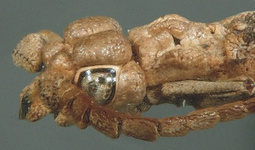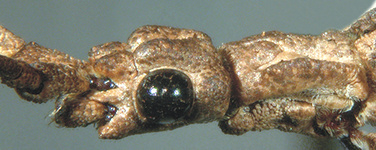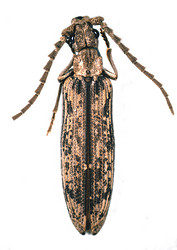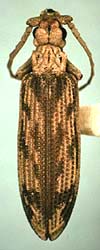Prolixocupes
Thomas Hörnschemeyer


This tree diagram shows the relationships between several groups of organisms.
The root of the current tree connects the organisms featured in this tree to their containing group and the rest of the Tree of Life. The basal branching point in the tree represents the ancestor of the other groups in the tree. This ancestor diversified over time into several descendent subgroups, which are represented as internal nodes and terminal taxa to the right.

You can click on the root to travel down the Tree of Life all the way to the root of all Life, and you can click on the names of descendent subgroups to travel up the Tree of Life all the way to individual species.
For more information on ToL tree formatting, please see Interpreting the Tree or Classification. To learn more about phylogenetic trees, please visit our Phylogenetic Biology pages.
close boxIntroduction
Only two extant species of Prolixocupes are known: Prolixocupes latreillei (Solier, 1849) from central Chile and western areas of Argentina close to the Chilean border between 25° and 35° southern latitude, and Prolixocupes lobiceps (Leconte, 1874) from western North America where it was found in a few localities in California and Arizona (USA).
The larvae of both species are unknown. Papp (1961) described an association of P. lobiceps with Plantanus racemosa Nutt. but beyond this nothing is known about the food sources and larval host plants.
Both species were originally described in the genus Cupes. Neboiss (1960) transferred them to his newly established genus Prolixocupes. Atkins (1963) identified Cupes boycei Papp, 1961 as a junior synonym of P. lobiceps.
Characteristics
Both species are of similar size, with P. lobiceps being a little bit smaller (c.10mm long & 3mm wide, P. latreillei is c. 12 mm long & 3 mm wide).
Characteristic features of the genus are the strong, long antennae, which are slightly serrate (more strongly in P. latreillei) and distinctly decrease in diameter from the basal to the distal antennomeres.
Both species also have the typical cupedine dorsal head protuberances, which are very large and bulbous. This feature is distinctly more conspicuous in P. lobiceps than in P. latreillei.
 P. lobiceps © Thomas Hörnschemeyer |  P. latreillei © Thomas Hörnschemeyer |
 P. lobiceps © Thomas Hörnschemeyer |  P. latreillei © Thomas Hörnschemeyer |
Discussion of Phylogenetic Relationships
According to Hörnschemeyer (2009) Prolixocupes is the sister group to all other Cupedidae except Priacma and Paracupes.References
Atkins, M. D. 1963. The Cupedidae of the world. Canadian Entomologist 95: 140-162.
Hörnschemeyer, T., 2009. The species-level phylogeny of archostematan beetles - where do Micromalthus debilis and Crowsoniella relicta belong? Systematic Entomology 34(3): 533-558.
Leconte, J. L. 1874. On the Cupesidae of North America. Transactions of the American Entomological Society 5: 87-88.
Neboiss, A. 1960. On the family Cupedidae, Coleoptera. Proceedings of the Royal Society of Victoria 72(1): 12-20.
Neboiss, A. 1984. Reclassification of Cupes Fabricius (s.lat.), with descriptions of new genera and species (Cupedidae: Coleoptera). Systematic Entomology 9:443-447.
Papp, C. S. 1961. Cupes boycei from Platanus racemosa Nutt. in California with a key to Nearctic species. Entomologische Berichten, Amsterdam 21: 210-214.
Solier, A. J. J. 1849. Coleópteros in Gay, C. (Ed.): Historia Fisica y Política de Chile. Zoologia Vol. 4. Privately published, Paris: 105-508.
Title Illustrations

| Scientific Name | Prolixocupes latreillei |
|---|---|
| Specimen Condition | Dead Specimen |
| Life Cycle Stage | Adult |
| View | Dorsal |
| Image Use |
 This media file is licensed under the Creative Commons Attribution License - Version 3.0. This media file is licensed under the Creative Commons Attribution License - Version 3.0.
|
| Copyright |
© 1996 David R. Maddison

|
| Scientific Name | Prolixocupes lobiceps |
|---|---|
| Image Use |
 This media file is licensed under the Creative Commons Attribution License - Version 3.0. This media file is licensed under the Creative Commons Attribution License - Version 3.0.
|
| Copyright |
© 1995 David R. Maddison

|
About This Page
Thomas Hörnschemeyer

University Göttingen, Institute for Zoology & Anthropology, Dept. Morphology & Systematics
Correspondence regarding this page should be directed to Thomas Hörnschemeyer at
thoerns@gwdg.de
Page copyright © 2010 Thomas Hörnschemeyer
 Page: Tree of Life
Prolixocupes .
Authored by
Thomas Hörnschemeyer.
The TEXT of this page is licensed under the
Creative Commons Attribution-NonCommercial License - Version 3.0. Note that images and other media
featured on this page are each governed by their own license, and they may or may not be available
for reuse. Click on an image or a media link to access the media data window, which provides the
relevant licensing information. For the general terms and conditions of ToL material reuse and
redistribution, please see the Tree of Life Copyright
Policies.
Page: Tree of Life
Prolixocupes .
Authored by
Thomas Hörnschemeyer.
The TEXT of this page is licensed under the
Creative Commons Attribution-NonCommercial License - Version 3.0. Note that images and other media
featured on this page are each governed by their own license, and they may or may not be available
for reuse. Click on an image or a media link to access the media data window, which provides the
relevant licensing information. For the general terms and conditions of ToL material reuse and
redistribution, please see the Tree of Life Copyright
Policies.
- Content changed 07 December 2010
Citing this page:
Hörnschemeyer, Thomas. 2010. Prolixocupes . Version 07 December 2010 (under construction). http://tolweb.org/Prolixocupes/9034/2010.12.07 in The Tree of Life Web Project, http://tolweb.org/









 Go to quick links
Go to quick search
Go to navigation for this section of the ToL site
Go to detailed links for the ToL site
Go to quick links
Go to quick search
Go to navigation for this section of the ToL site
Go to detailed links for the ToL site